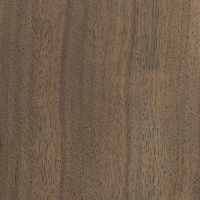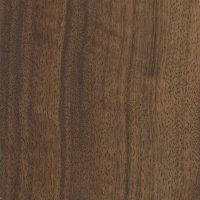 |
Common Name(s): Indian Laurel Scientific Name: Terminalia elliptica (syn. T. tomentosa) Distribution: Southern Asia (primarily India and Myanmar) Tree Size: 65-100 ft (20-30 m) tall, 2-3 ft (.6-1 m) trunk diameter Average Dried Weight: 54 lbs/ft3 (855 kg/m3) Specific Gravity (Basic, 12% MC): .73, .86 Janka Hardness: 2,340 lbf (10,390 N) Modulus of Rupture: 14,710 lbf/in2 (101.4 MPa) Elastic Modulus: 1,806,000 lbf/in2 (12.46 GPa) Crushing Strength: 8,220 lbf/in2 (56.7 MPa) Shrinkage: Radial: 4.8%, Tangential: 7.4%, Volumetric: 13.2%, T/R Ratio: 1.5 |
Color/Appearance: Varies from light brown to dark brown with darker, nearly black streaks. Sapwood is a pale pinkish color, clearly demarcated from the heartwood.
Grain/Texture: Grain is generally straight or slightly interlocked or irregular. With a medium to coarse uniform texture and low natural luster.
Endgrain: No data available.
Rot Resistance: Rated as moderately durable; poor insect resistance.
Workability: Generally easy to work, though sections with interlocked or irregular grain are more problematic. Turns and finishes well.
Odor: No characteristic odor.
Allergies/Toxicity: Although severe reactions are quite uncommon, Indian Laurel has been reported to cause skin irritation. See the articles Wood Allergies and Toxicity and Wood Dust Safety for more information.
Pricing/Availability: Most commonly available as decorative veneer. Expect prices to be moderate for an imported hardwood.
Sustainability: This wood species is not listed in the CITES Appendices or on the IUCN Red List of Threatened Species.
Common Uses: Veneer, furniture, cabinetry, boatbuilding, turned objects, and other small specialty items.
Comments: No data available.
- Idigbo (Terminalia ivorensis)
- Indian Silver Greywood (Terminalia bialata)
- Limba (Terminalia superba)
- Nargusta (Terminalia amazonia)
None available.
Scans/Pictures: A special thanks to Steve Earis for providing the veneer sample of this wood species.






For beginners, its good to remember the wood used in the box (back and sides) should be a very dense:wood to sustain, capture and reverberate within the box, simultaneously captured by the tone wood – the top, usually a much softer wood like spruce and cedar. The sound quality is a combination of box, bouncing the string vibrations back to and through the sound wood and the hole (or perforations). Cover the hole and you can feel and hear the tonal quality of the guitar, and that is directly related to the quality of materials used. Every element of the… Read more »
It is interesting to note that both Gibson and Fender are now using this wood as a substitute for rosewood for the fretboards on their budget Epiphone and Squier guitars. Gibson still use rosewood for their own brand guitars – with the exception of the odd few that have ebony fretboards, Fender’s higher end instruments still use rosewood but the low to middle ranges now use pau ferro.
I bought a limited production Larrivee guitar several years ago that was made with Indian Laurel. It was used in construction of the backs and sides. This guitar has extraordinary tonal qualities and is one the finest guitars I have ever owned. In fact I would say that Indian Laurel is comparable to Brazilian Rosewood in tonal quality.
Is it the same wood they call Taukkyan in Myanmar?
Is it same species with Terminalia Catappa (Indian Almond) ?
If its different with Catappa, would you please to add Catappa wood identification.
Thankyou
I just bought a Taylor guitar that has Laurel Back and sides, and it sounds Amazing!!!!
Most of the sound of an acoustic guitar comes from the top, not the back and sides. That’s why most acoustics are made with cheaper woods or are laminated. I have a Taylor Big Baby which is at their low end. It has a laminated back and sides, yet it sounds great, too. The important part is having a solid top. Of course, if it’s made by Taylor, it doesn’t matter what wood they use. It’s going to sound great.
Taylor does seem to well research their woods, and explains their wood choices a lot in their Wood and Steel high gloss magazine, which I think comes every three months or so if you are an owner signed up with them (they just started sending them to me when I registered the guitar on their website). I bought a new turn of the century, maybe 2001 or so, Taylor 514CE. It’s pretty warm sounding with the solid red cedar top and solid sapelle sides and backs (some kind of African mahogany they utilize), but still has plenty of clarity. It’s… Read more »
The better ones sound good all around.
Most guitars are made with laminates because they are cheaper to produce. My first guitar was a Gibson L model made with laminates. It was quite playable and I really enjoyed it. A few years later I picked up a 50s Martin D-28 with Brazilian Rosewood back and sides. It was as though I had been living in a guitar desert. The tone was vastly superior to that Gibson . I’ve owned and played a lot guitar since then and I have never played a guitar made with laminated wood that could hold a candle to a quality solid wood… Read more »